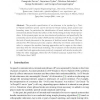Free Online Productivity Tools
i2Speak
i2Symbol
i2OCR
iTex2Img
iWeb2Print
iWeb2Shot
i2Type
iPdf2Split
iPdf2Merge
i2Bopomofo
i2Arabic
i2Style
i2Image
i2PDF
iLatex2Rtf
Sci2ools
TSD
2005
Springer
2005
Springer
Experimental Evaluation of Tree-Based Algorithms for Intonational Breaks Representation
Abstract. The prosodic specification of an utterance to be spoken by a Textto-Speech synthesis system can be devised in break indices, pitch accents and boundary tones. In particular, the identification of break indices formulates the intonational phrase breaks that affect all the forthcoming prosody-related procedures. In the present paper we use tree-structured predictors, and specifically the commonly used in similar tasks CART and the introduced C4.5 one, to cope with the task of break placement in the presence of shallow textual features. We have utilized two 500-utterance prosodic corpora offered by two Greek universities in order to compare the machine learning approaches and to argue on the robustness they offer for Greek break modeling. The evaluation of the resulted models revealed that both approaches were positively compared with similar works published for other languages, while the C4.5 method accuracy scaled from 1% to 2,7% better than CART.
500-utterance Prosodic Corpora | Break Indices | Greek Break Modeling | Signal Processing | TSD 2005 |
| Added | 28 Jun 2010 |
| Updated | 28 Jun 2010 |
| Type | Conference |
| Year | 2005 |
| Where | TSD |
| Authors | Panagiotis Zervas, Gerasimos Xydas, Nikos Fakotakis, George K. Kokkinakis, Georgios Kouroupetroglou |
Comments (0)

